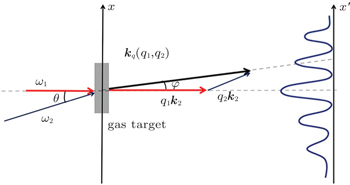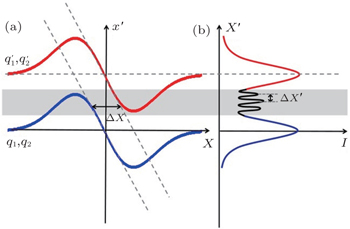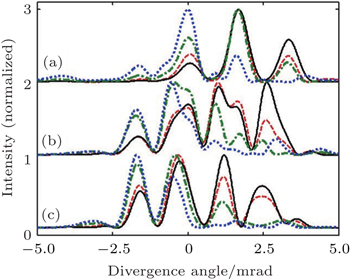† Corresponding author. E-mail:
‡ Corresponding author. E-mail:
Project supported by the National Key Basic Research Program of China (Grant Nos. 2013CB922401 and 2013CB922402), the National Key Scientific Instrument and Equipment Development Projects, China (Grant No. 2012YQ12004704), the National Natural Science Foundation of China (Grant No. 11374356), and the International Joint Research Program of National Natural Science Foundation of China (Grant No. 61210017).
High-order harmonic generation (HHG) driven by two non-collinear beams including a fundamental and its weak second harmonic is numerically studied. The interference of harmonics from adjacent electron quantum paths is found to be dependent on the relative delay of the driving pulse, and the dependences are different for different harmonic orders. This frequency dependence of the interference is attributed to the spatial frequency chirp in the HHG beam resulting from the harmonic dipole phase, which in turn provides a potential way to gain an insight into the generation of high-order harmonics. As an example, the intensity dependent dipole phase coefficient α is retrieved from the interference fringe.
High-order harmonic generation (HHG) from the non-perturbative nonlinear interaction between intense femtosecond laser pulses and atoms or molecules has been proven to be a reliable coherent source in extreme ultraviolet (XUV) and soft x-ray spectral regions.[1,2] HHG driven by monochromatic or bichromatic laser in a collinear geometry has been extensively studied both experimentally[3–6] and theoretically[7–11] in the past years, the non-collinear HHG has received less attention, owing to its complex geometry. Nevertheless, the non-collinear geometry provides a natural way of separating the high harmonics from the fundamental beam, especially for the high harmonic radiation output coupling in an enhancement cavity of XUV frequency comb.[12,13] It is also beneficial to better phase matching in HHG.[14] The HHG process may be well described by the simple three-step model:[15] an valence electron is firstly tunnel-ionized out of an atom in the strong laser field into the continuum state, then is accelerated and brought back to the atom by the laser field, finally recombines with the parent nuclei to emit a high energy photon. Quantum paths of the electrons are usually categorized by the excursion time in the continuum state, the shortest two of which are the well-known short and long trajectories. In a two-color scheme, HHG may be understood as high-order sum and difference frequency mixing.[16] For instance, when the fundamental frequency ω1 and the weak second harmonic ω2 a beam are mixed, a harmonic photon ω is produced by absorbing (positive number) or emitting (negative number) q1 photons with ω1 and q2 photons with ω2. This gives another way of determining the quantum paths which are characterized by the photon number (q1, q2). A combination of q1 photons and q2 photons, which obeys the transition selection rules contributes to the HHG spectrum.[5] All the contributions from different photon numbers (q1, q2) of the same frequency ω overlap spatially in the collinear two-color scheme, thus the individual quantum path is undistinguishable. The two-color HHG has been extended to non-collinear geometry by two[17] and even multiple laser beams.[18] Spatially discrete harmonics have been observed in non-collinear two-color HHG spectra which are explained in terms of the conservations of energy, momentum, and parity. Different paths (q1, q2) with the same harmonic frequency ω correspond to different propagation angles because of the momentum conservation, making it possible to separate individual quantum path in the space domain. The spatial separation of non-collinear HHG has been proposed to isolate single attosecond pulse[19] and study the orbital angular momentum transferring from fundamental to HHG.[20] Recently the phase matching effect and interference between adjacent paths in non-collinear HHG have been investigated[21] as a frequency-domain analogy to the early work concerning the quantum path interferences for trajectories with different excursion times.[22–24] The interference is explained by the dipole phase difference among harmonics from different source positions.
In the present paper, we numerically simulate the non-collinear HHG to provide a clear understanding of the quantum path interference. The frequency dependence of this interference is identified, which is attributed to the spatially dependent dispersion of the dipole phase of the atom. In our simulation the single atom response is calculated by solving time dependent Schrodinger equation (TDSE) in strong field approximation (SFA)[25] with which a quantum analysis of the classical three step model is performed. In the SFA, the excited states and Coulomb field are not taken into account. The propagation effect in the gas target is ignored and only a single slice is considered as the HHG source in the calculation, which is infinitely thin in the propagation dimension and includes the beam profile in the lateral dimension. The far-field HHG spectra at a distance of 100 cm are calculated by the Huygens’ integral of the near-field distribution in Fresnel approximation.[26] The driving field is composed of two Gaussian beams with frequencies ω1 and ω2 crossing with a small angle θ at the focus of both beams. A schematic of the simulation geometry is given in Fig.
The simulation result for a strong fundamental field ω1 (2 × 1014 W/cm2, 800-nm wavelength) and a weak second harmonic ω2 (0.2 × 1014 W/cm2, 400-nm wavelength) with a crossing angle θ = 8.7 mrad is shown in Fig.
Only a single slice of neon atoms placed at the focus was considered. The weak field ω2 gives rise to even order harmonics as well as the off-axis discrete harmonics as shown in the spectra. The position of each discrete harmonic is determined by the conservation rules,[17]

The propagation angle φ = θ q2ω2/ω predicted by the conservation rules is fitted well with our simulated spectra for orders lower than 25. The non-collinear HHG spectrum presents a spatial mapping of quantum paths determined by the photon absorption (emission) numbers (q1, q2). It is possible to distinguish different (q1, q2) paths for a certain harmonic frequency ω by their unique propagation angle φ.
The angular gap of neighboring quantum paths Δφ = 2θ ω2/ω is inversely proportional to the harmonic frequency ω. On the other hand the divergence of the discrete harmonic increases with frequency increasing.[27] This makes the angular gap of discrete harmonics relatively large for low orders, and ensures the contribution of each quantum path to be resolvable in harmonic spectrum at far field. When the gap is comparable to or even smaller than the divergence of the discrete harmonics, the interference of adjacent paths appears. In Fig.
The interference between adjacent quantum paths may be understood in a framework of frequency chirp induced by the intensity-dependent dipole phase.[29,30] The dipole phase is given by 





The interference fringe interval Δx′ is mainly determined by Δx. Since the HHG distribution usually concentrates in the central part of the laser beam where the chirp is almost linear, an approximation of Δx from the calculation of Eq. (

The effect of the dipole phase is not so straight forward. At certain intensity I0, the coefficient α varies with harmonic order. A plot of α calculated by a saddle point analysis[33] as a function of harmonic order for short trajectories in the mixed laser field ω1 and ω2 is shown in Fig.

In order to improve the accuracy of the retrieval, larger beam waist 100 μm and crossing angle 17.5 mrad are chosen to acquire fine interference fringes as shown in Fig. 

The discussion above is also valid for long trajectory that has larger coefficient α and therefore more complicated interference pattern. Since short and long trajectories may be separated experimentally by phase matching[34] or spatial filtering[35] and theoretically by selecting the electron excursion time, it is reasonable to restrict the discussion to short trajectory for simplification.
To know the validity of our single slice gas target calculation, We calculate the spectra by a non-adiabatic two-dimensional propagation model modified in Ref. [36] as macroscopic effect plays an important role in HHG.[37] In the case of non-collinear beams, radial asymmetry assumed in Ref. [36] is not available. Therefore the two-dimensional grid, which is in the plane formed by wave vector
The discrete structure for low orders and the interference pattern for high orders survive after the 1-mm-long propagation in the gas medium. In 2-mm or longer gas target, the dominating peaks move towards the difference-frequency side (q2 < 0). This shift may be explained by the additional geometrical phase mismatch term induced by the non-collinear geometry.[21] The sign of additional mismatch term Δ
In this work, the high-order harmonic radiation produced by two non-collinear beams with fundamental frequency at 800 nm and its weak second harmonic is numerically studied. We determine quantum paths by photon absorption (emission) number (q1, q2) and observe the spatial separation of the paths in the non-collinear scheme. Moreover, the interference between the adjacent paths is observed in high orders. The role of dipole phase in the interference is investigated and the coefficient α is retrieved from the interference fringe. The strong dependence on the CEP and delay between the driving pulses is also proven. The results in this work demonstrate the possibility of extracting the information about the quantum paths encoded in the interference spectra, which cannot be realized in a collinear scheme.
| 1 | |
| 2 | |
| 3 | |
| 4 | |
| 5 | |
| 6 | |
| 7 | |
| 8 | |
| 9 | |
| 10 | |
| 11 | |
| 12 | |
| 13 | |
| 14 | |
| 15 | |
| 16 | |
| 17 | |
| 18 | |
| 19 | |
| 20 | |
| 21 | |
| 22 | |
| 23 | |
| 24 | |
| 25 | |
| 26 | |
| 27 | |
| 28 | |
| 29 | |
| 30 | |
| 31 | |
| 32 | |
| 33 | |
| 34 | |
| 35 | |
| 36 | |
| 37 | |
| 38 | |
| 39 |









